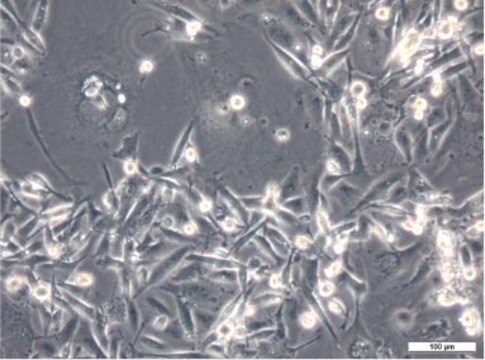About This Item
Kod UNSPSC:
41106514
Polecane produkty
product name
VP303, 05092806
pochodzenie biologiczne
human breast
tryb wzrostu
Adherent
kariotyp
Mean no. 64, modal no. 67, range 57-72
morfologia
Epithelial
produkty
Not specified
receptory
Not specified
metody
cell culture | mammalian: suitable
powiązane choroby
cancer
Warunki transportu
dry ice
temp. przechowywania
−196°C
Pochodzenie linii komórkowej
Human Breast Cancer
Opis linii komórkowej
Derived from a breast cancer biopsy removed from a 69 year-old female. The histology of the breast cancer biopsy was defined as Ductal Grade II, 90% of tumour cells stained positive for oestrogen receptors and cells were negative for progesterone receptor staining. The VP303 cell line derived from the tumour did not stain positive for oestrogen receptors. The individual was recorded to be alive 5 years after surgery performed to remove the tumour. This cell line grows slowly and is relatively difficult to culture; please read the sub-culture routine information closely.
pożywka hodowlana
MEBM (Clonetics, CC-3151) + MEGM SingleQuots (Clonetics, CC-4136) + 2mM Glutamine + 2% Foetal Bovine Serum (FBS). Fresh EGF (final concentration of 10ng/ml) should be added to the medium at each subculture.
Rutyna subkultury
Split sub-confluent cultures (70-80%) 1:2 i.e. seeding at 2-5x10,000 cells/cm2 using 0.25% trypsin; 5% CO2; 37°C. The VP series of breast cancer cell lines are very slow growing and relatively difficult to grow. Fresh EGF (final concentration 10ng/ml) s
Inne uwagi
Additional freight & handling charges may be applicable for Asia-Pacific shipments. Please check with your local Customer Service representative for more information.
This page may contain text that has been machine translated.
Certyfikaty analizy (CoA)
Poszukaj Certyfikaty analizy (CoA), wpisując numer partii/serii produktów. Numery serii i partii można znaleźć na etykiecie produktu po słowach „seria” lub „partia”.
Masz już ten produkt?
Dokumenty związane z niedawno zakupionymi produktami zostały zamieszczone w Bibliotece dokumentów.
Nasz zespół naukowców ma doświadczenie we wszystkich obszarach badań, w tym w naukach przyrodniczych, materiałoznawstwie, syntezie chemicznej, chromatografii, analityce i wielu innych dziedzinach.
Skontaktuj się z zespołem ds. pomocy technicznej


